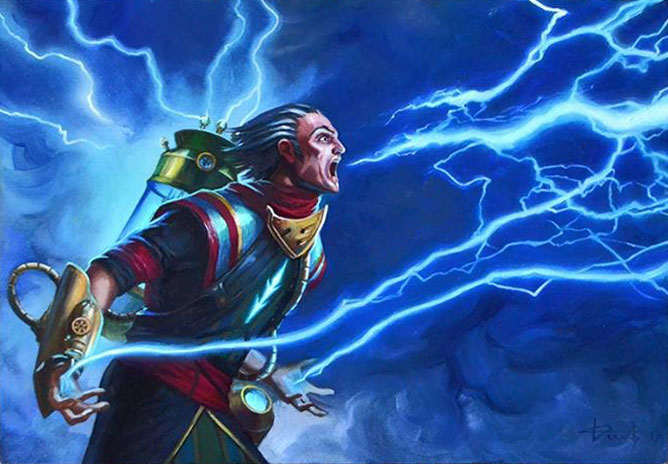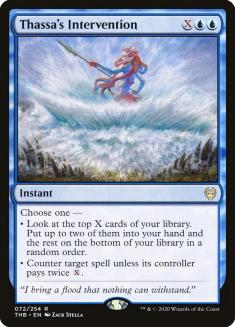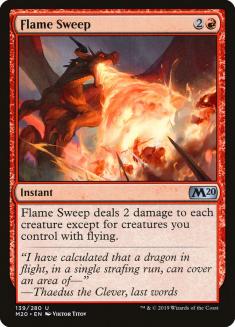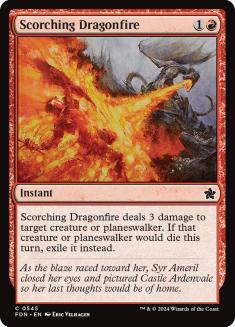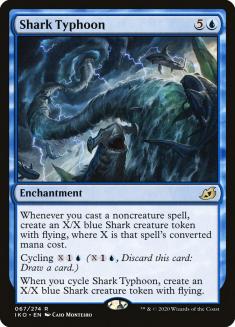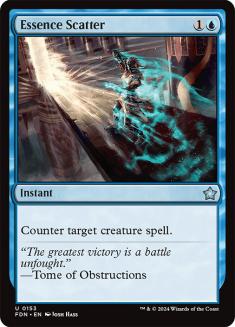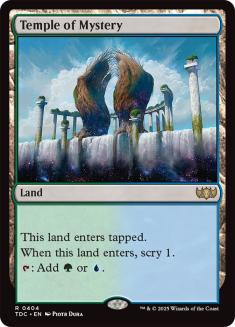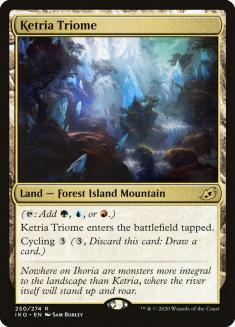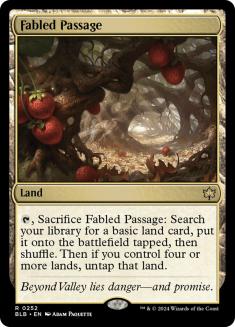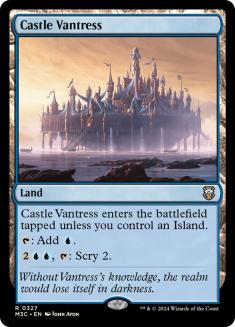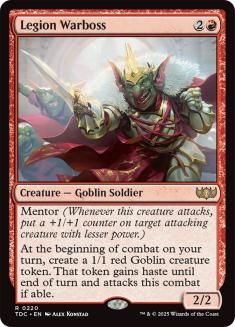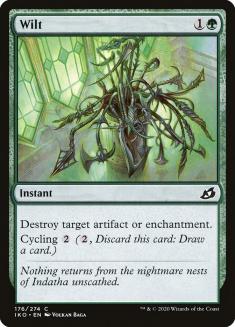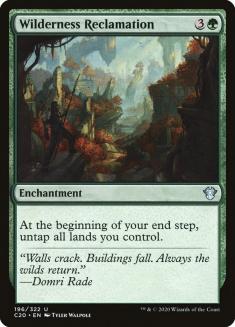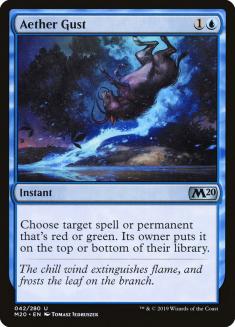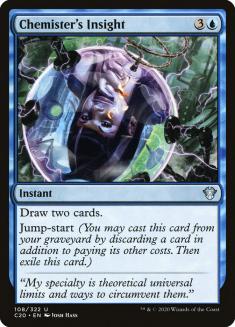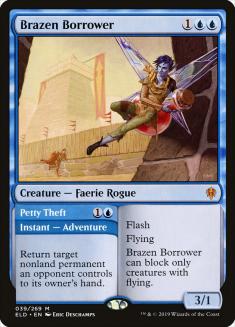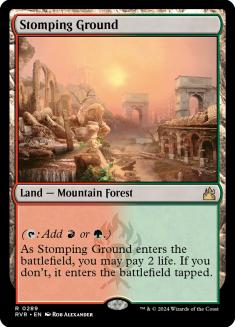Temur Reclamation is Ikoria Standard’s future breakout deck. There are three reasons:
- The metagame is largely settling into midrange, which bodes well for the deck that goes over the top of other midrange decks.
- Creature decks have settled into a space where they’re weak to Flame Sweep and Uro, two of the best cards in Temur Reclamation’s arsenal. Having access to Essence Scatter solves some problems as well, such as having issues dealing with flash creatures and larger threats in general.
- Shark Typhoon gives Temur Reclamation another angle of attack against Teferi, Time Raveler and flash decks.
My decklist is different from most of the versions I’ve seen out there.
Creatures (4)
Lands (28)
Spells (28)
- 4 Opt
- 2 Essence Scatter
- 1 Chemister's Insight
- 3 Expansion
- 4 Growth Spiral
- 4 Wilderness Reclamation
- 3 Flame Sweep
- 2 Scorching Dragonfire
- 2 Thassa's Intervention
- 3 Shark Typhoon
Sideboard

The Gameplan And Maindeck
Temur Reclamation’s main way of winning is by combining its namesake with Explosion. Because of that, the vast majority of players will include four copies of Expansion // Explosion in their deck in order to maximize their ability to assemble that combo, but that’s no longer necessary.
You could also think of Opt as something of a split card. With four copies of Opt in your deck, you’ll be able to find as many copies of Expansion // Explosion as most players that play four copies of Expansion // Explosion and zero copies of Opt. Unless there’s a matchup where you explicitly need all four copies of Expansion // Explosion in your deck for threat density, such as the old Azorius Control matchup with four Dovin’s Vetos, shaving a copy is acceptable and encouraged. Shark Typhoon adds to the threat density and drawing Expansion // Explosion early isn’t ideal.
Thassa’s Intervention performs a similar job. When you’re casting it in Dig Through Time mode, X is usually large enough that it will be able to find something that helps your current situation. Since you tend to see the majority of your deck in many of your games, you don’t have to play as many win conditions. If the win conditions were also good on defense, such as Uro, then it’d be a different matter.
Since your end-game tends to go over the top of what everyone else is doing, the early-game is often the most important part of any game. Whether you escape the early-game unscathed determines whether you win, so I have more early interaction than most players. I tend to mulligan clunky hands, especially on the draw. In order to not have to mulligan every game, you want more early interaction and ways to catch back up if you fall behind.
Not playing Flame Sweep maindeck is a mistake. Without a sweeper, your matchup against Lurrus decks is much worse. Storm’s Wrath is a little slow and Flame Sweep deals with most of the cards people are playing. The only downside is that Storm’s Wrath is occasionally able to damage a Teferi, Time Raveler or Narset, Parter of Veils. You usually end up losing those games regardless of Storm’s Wrath, though.
Scorching Dragonfire is my spot removal spell of choice. Although Anax, Hardened in the Forge isn’t quite as prevalent as it used to be, the exile clause still tends to be useful against decks with Lurrus. Fire Prophecy is an awesome card, and one that I’d love to be able to play, but not hitting planewalkers is very relevant.
I’m happy playing four Uro, Titan of Nature’s Wrath, although I’m less sold on that number being optimal. Since I don’t have access to maindeck Mystical Dispute, most of my Game 1s are won with brute force, as I won’t have many ways to interact with some strategies. With fewer Aether Gusts and fewer Teferi, Time Ravelers, that plan doesn’t have many downsides. Additionally, Uro is the best card against Lurrus Rakdos Sacrifice.
One of the biggest pickups for Temur Reclamation has been Shark Typhoon, largely because of how strong opposing blue decks are at the moment. Decks like Azorius Control can’t really exist because trying to play “draw-go” will eventually lead to them being eaten by Sharks. Similarly to Uro, it’s a fine defensive card in most situations, even if you’re cycling for a chump blocker. I’ve certainly cast the card and it’s been powerful, but that happens in very few instances.
Essence Scatter is an amazing card that I’ve played in most Standard formats where it’s been legal. Being able to stop an expensive creature for only two mana creates huge tempo swings and this Standard format is no different. It’s not quite as good as when Gyruda, Doom of Depths was a deck, but with most decks having a companion, it’s one of the easiest ways to answer them.
Velocity is hugely important for this deck, which is why I’ve built the deck to rarely have unspent mana. Having access to a plethora of cards with X in their mana costs helps with that to some degree, but Opt, Growth Spiral, Uro, Chemister’s Insight, and even Thassa’s Intervention allow you to tear through your deck quickly. Being able to see a large portion of your deck on any given turn makes it likely you’ll be able to piece together whatever you need.
Opt is a huge part of that but so is Chemister’s Insight, which I’d really like a second copy of in the maindeck. There are so many turns where you’re playing “draw-go” with your opponent, especially in sideboard games, and Chemister’s Insight is the perfect way to pull ahead while not being vulnerable to countermagic. It’s also one of the best ways to utilize the Wilderness Reclamation untap.
The Manabase
Some lists trend as high as 30 lands but I’ve played as few as 26. When you’re maxing on Growth Spiral and Uro, you want to ensure those cards actually function as acceleration, so I’m playing more lands that I normally would. There are a few matchups where the sideboard games can be attrition-based, so shaving a land in those matchups makes sense.
We have 22 blue sources, eighteen green, and seventeen red, numbers that were impossible before Ketria Triome without playing more lands. If Temples were stronger than Triomes in the deck, you could make a case for having fewer sources of each color because you’d still be able to operate cleanly. However, that’s not the case, especially in this deck.
Temples are still quite good in the deck but you’d prefer to have the option of cycling away excess lands in the late-game rather than flooding out and only having some scrys to show for it. If the cycling on Triomes weren’t so clunky at three mana, I’d probably play extra Triomes over the Temples I currently have. At three mana, I think I wanted exactly four Triomes, which means I get to fill out the manabase with a couple of Temples to still get that early-game filtering.
Since we do have plenty of colored mana sources, we no longer have to play all twelve shocklands. I’ve gone as low as ten and the Triomes have still helped hold everything together. With fewer shocklands and more land in general, we can play four Fabled Passage to fuel our Uros.
Basic Mountain isn’t ideal for Growth Spiral and escaping Uro, Titan of Nature’s Wrath but you need one for Fabled Passage. I also don’t want any basic Forests past the two that are required for escaping Uro. That leaves slots for two to five basic Islands (or Castle Vantresses).
I strongly dislike Castle Vantress in this deck for numerous reasons. Although Ketria Triome reduces the downside, Castle Vantress isn’t “free” and comes with an opportunity cost. In games where you don’t lead with a multicolor land, Castle Vantress will severely inhibit your ability to curve out.
Finally, when you’re activating Castle Vantress, it’s often in games where you’re losing. The small amount of filtering likely won’t make up for whatever deficit you’re facing. I’d rather build my deck to have ways to continually use its mana so it never comes down to using Castle Vantress. Things like Chemister’s Insight, Uro, and Thassa’s Intervention should ensure that you never have to use Castle Vantress.
There are small tweaks you could make to the manabase but I’m very happy with what I have.
The Sideboard
For the most part, you need sideboard plans for two different sorts of matchups. There are those where you’re trying to stabilize and go over the top of aggro decks and those where you have to fight opposing countermagic and a clock.
What you need against aggro is mostly front-loaded because of the prevalence of Lurrus Rakdos Sacrifice and the fact that those matchups tend to be more difficult than other midrange decks. Stabilizing against those decks is so difficult if you don’t have a sweeper and I can’t imagine how people win Game 1 against Rakdos Sacrifice without them.
Fry needs to make a comeback. Not only is Jeskai Fires prevalent, but Yorion Bant Midrange is also quite good. Many players probably think their maindeck Mystical Disputes are good enough but you really want a clean answer to Teferi in case it actually resolves.
Sideboarding a small threat is something I’ve done in the past. Robber of the Rich, Legion Warboss, and Spectral Sailor have all performed well at various points but aren’t necessary right now. The midrange battle is often fought on the battlefield and you have the tools to keep it clear. Tapping out on Turn 3 is often too dangerous because they could have an answer, like Mystical Dispute or Aether Gust, and resolve something threatening of their own. Shark Typhoon also plays that role at the moment.
If I were going to sideboard a threat, it would be Legion Warboss. Spectral Sailor doesn’t get to activate very often and Robber of the Rich is too small-ball. Legion Warboss kills people quickly and is excellent against planeswalkers, so it’s the easy choice.
The Variations
Since I’m doing things differently than other folks, here’s a helpful infographic so you can get a glimpse of what everyone else is having success with.
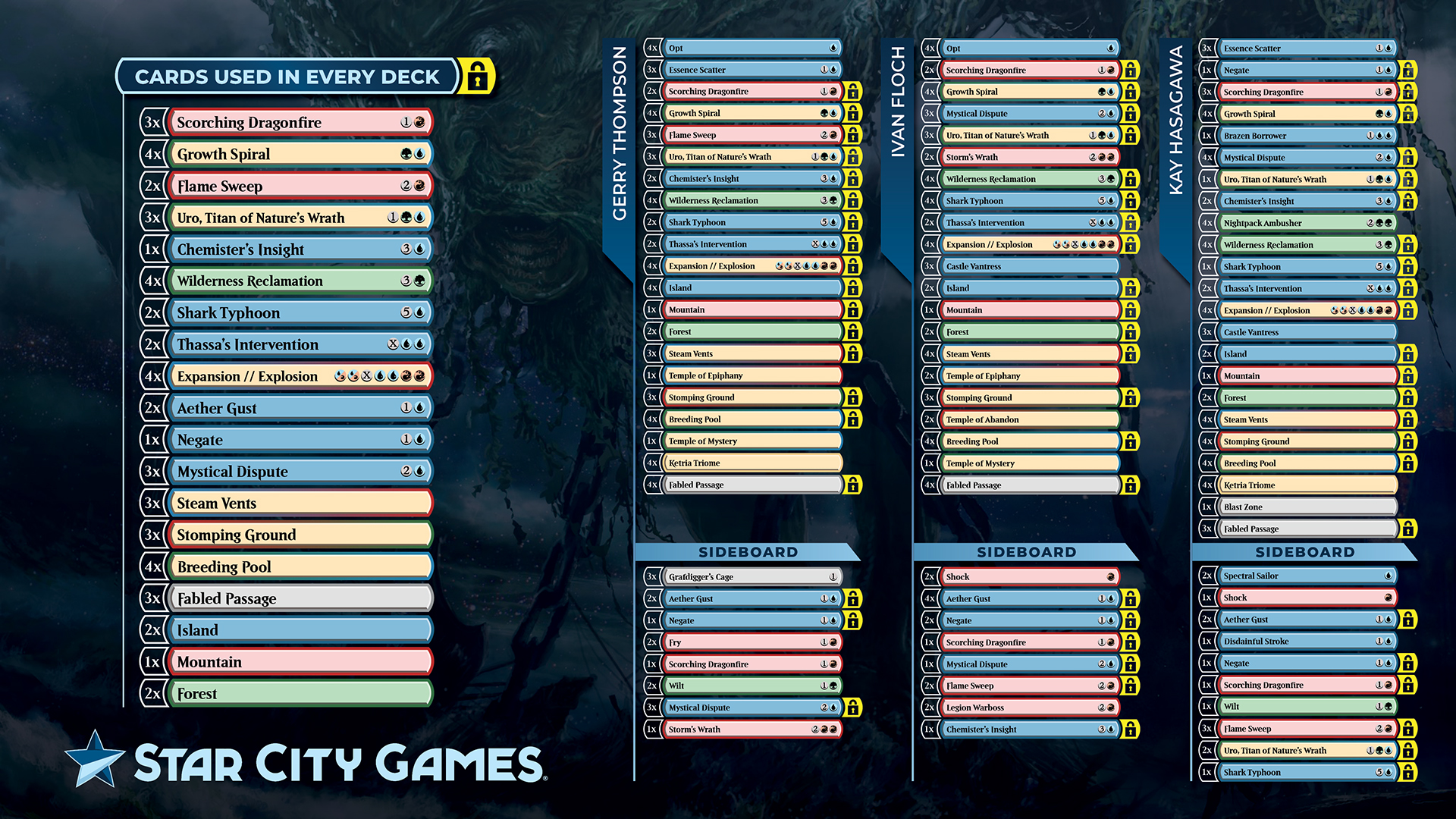
Image idea comes from Ray “blisterguy” Walkinshaw. Follow him on Twitter and support him on Patreon @blisterguy
The main variations are last season’s version with Brazen Borrower, the updated version with lots of Shark Typhoons, and a hybrid version with Nightpack Ambusher and/or Frilled Mystic. The Shark Typhoon versions are very good at the moment, although the four-drops are very powerful in the same matchups Shark Typhoon is good.
Since Shark Typhoon is so strong in the mirror and typically more impactful than the four-drops in other matchups, it wouldn’t surprise me if the hybrid versions fade out. Two of the ways to beat bigger creatures, Aether Gust and Essence Scatter, can’t do anything to stop Shark Typhoon, so a return to Brazen Borrower is likely in order too.
Mystical Dispute, Opt, and Chemister’s Insight are the largest points of contention. I’ve stated my preferences already and wouldn’t play without Opt and some amount of Chemister’s Insights. However, Mystical Dispute isn’t something I’m against by any means. I’d just prefer to have more game against Lurrus decks.
Matchup Guide
VS Lurrus Rakdos Sacrifice
Out:
In:
Since you’ll rarely give them the opportunity to truly get their engine online, their gameplan usually comes down to nickel-and-diming you out. Uro is very important for keeping your life total high until you can start doing powerful things. In the meantime, you’ll be killing creatures, drawing cards, and sculpting your end-game.
If they have a lot of disruption, Chemister’s Insight is solid. Otherwise, it’s too slow against their fast draws. Plus, Rakdos Sacrifice has very few ways to disrupt Wilderness Reclamation or Explosion, so you don’t need to sculpt in order to find a window, nor do you need additional filtering assuming your combo isn’t going to come together. If you want the second Chemister’s Insight, I’d suggest cutting Shark Typhoon or the other Thassa’s Intervention.
One play that’s come up a decent amount of the time is using Expansion on their Claim the Firstborn in order to take something like Serrated Scorpion or Dreadhorde Butcher. It prevents you from taking a ton of damage and you get their dies trigger. They’re drawing a card from Uro, but you’re mostly trying to keep your head above water and don’t necessarily care about that aspect. If they have Witch’s Oven, it’s trickier, but it’s another reason to have something like Wilt. That play also means they have to choose between preventing you from having a blocker or getting your Uro back.
If you want easier wins, you could play some copies of Grafdigger’s Cage but I haven’t found it to be necessary. It can also be awkward with your Uros but Cage normally shuts them down enough that you don’t need Uro regardless.
VS Keruga Jeskai Fires
Out:
In:
Legion Warboss out of the sideboard is somewhat scary but your counterspells and Aether Gusts are typically good enough answers. If you want, you can keep in the Scorching Dragonfires and leave the Wilt and a Chemister’s Insight on the bench.
For the most part, you’re trying to stop what they’re doing because they have disruption to stop your end-game and they snowball quickly. If you can deal with their first few threats, you’ll often have enough breathing room to do your thing.
If they play aggressively, as they should, Chemister’s Insight will likely feel too clunky. It all depends on your opponent and what their plan is.
VS Temur Reclamation
Out:
In:
The mirror is typically about who has to make a move first, usually due to missing land drops and falling behind. That leads to their opponent easily answering whatever they were trying to do and resolving something game-breaking.
Sitting back and sculpting isn’t a winning strategy because of Shark Typhoon, unless you actually have an answer. Despite the games going on for a while and the end-game consisting of flashy plays, the early-game matters a ton. Whoever makes the best exchanges early is going to have a huge advantage and that tends to snowball.
If you want a hammer for the mirror match, Narset, Parter of Veils is one of the best cards you could use. Most people don’t have threats aside from Shark Typhoon and Narset typically shuts down their engines hard.
VS Yorion Bant Midrange
Out:
In:
Don’t expose Wilderness Reclamation to Elspeth Conquers Death unless you can really punish them for tapping out on the following turn. Avoiding situations like that is why I often trim copies on Wilderness Reclamation when sideboarding against decks that could easily punish you with things like Aether Gust.
There will often be situations where committing your four-mana, sorcery-speed namesake will end poorly. At that point, you’d prefer to not draw copies of the card early and you certainly don’t want to draw multiples when you wouldn’t be able to cast them for fear of losing the game on the spot to a poor exchange. During that dance where you’re trying to angle for a spot to slip Wilderness Reclamation onto the battlefield, having Chemister’s Insight to spend mana on is perfect.
Kanister’s version of Bant doesn’t have many Aether Gust targets and I fully expect people to lean toward his decklist in the coming weeks. After sideboard, Kanister has Knight of Autumn and Agent of Treachery as high-value Essence Scatter targets. Even nabbing an escaping Uro is fine.
VS Lurrus Jeskai Cycling
Out:
In:
Obviously this matchup is different from most of the decks in Ikoria Standard. They have a solid beatdown plan, the ability to go long, disruption, and Zenith Flare to finish. On paper, it’s a scary matchup. Their sideboard isn’t highly developed yet. As such, it isn’t much of a threat but part of that is because they’re building around Lurrus.
Flame Sweeps are great for keeping the tokens under control while the spot removal is mostly ineffective. You can’t let a Flourishing Fox get out of control but you also don’t care too much about their Runeclaw Bear pressure. Conserve your life total, don’t lose to Improbable Alliance or Zenith Flare and you should be good.
I haven’t tried bringing in Mystical Dispute to fight early Alliances or mid-game Aether Gusts and Mystical Disputes but it could be a viable strategy.
Conclusion
Temur Reclamation is already one of the decks putting up results in Standard and it wouldn’t surprise me if we’re on the verge of a complete Temur Reclamation takeover. At this point, the deck has the tools for any solution and can shift roles in sideboarding seamlessly. Those setups tend to be the most powerful in any given Standard format and this one doesn’t seem like an exception.
Rakdos Sacrifice (whether it’s Lurrus or Obosh, the Preypiercer) might be the best deck at the moment, but that won’t last.

